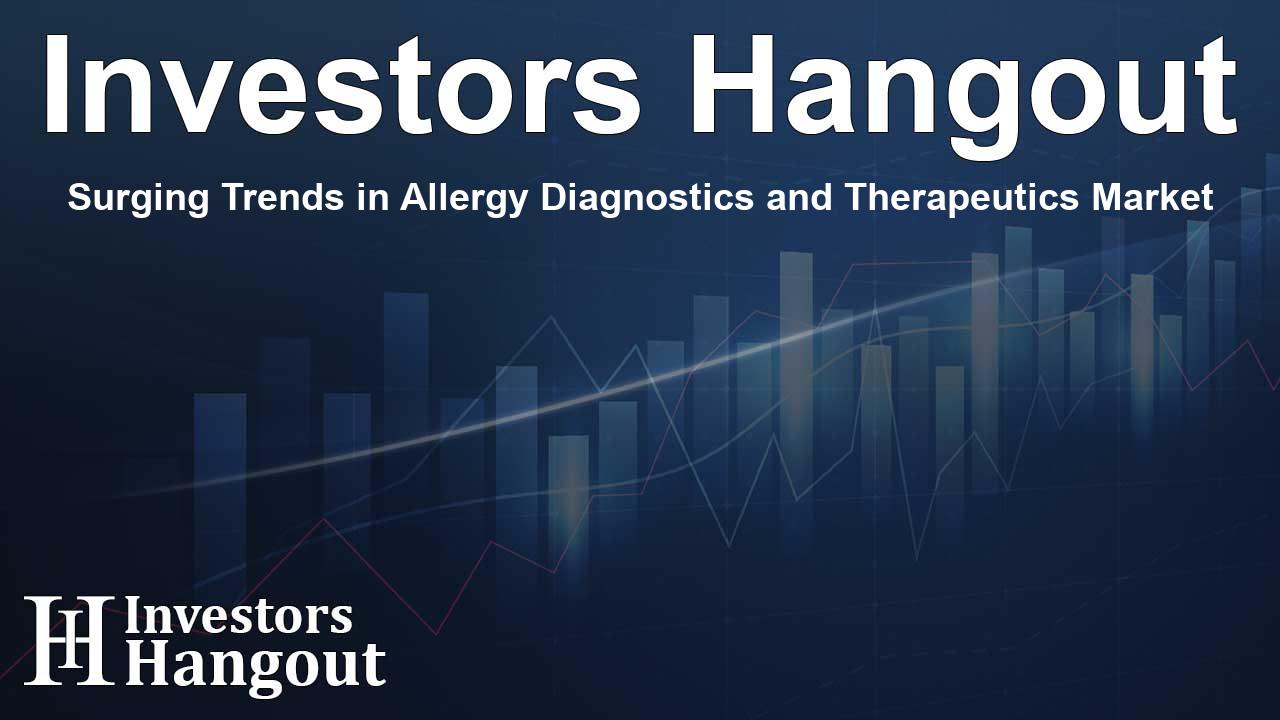Surging Trends in Allergy Diagnostics and Therapeutics Market

Allergy Diagnostics and Therapeutics Market Overview
In recent years, the Allergy Diagnostics and Therapeutics market has experienced significant growth, driven by increasing allergy prevalence and advancements in diagnostic technologies. The market is expected to grow substantially, aiming for a valuation of approximately USD 78,036.1 Million by the year 2033, according to recent research findings.
Key Growth Drivers in the Allergy Market
Several pivotal factors are driving the growth of the Allergy Diagnostics and Therapeutics market:
Rising Allergy Prevalence
The global rise in allergic conditions can be attributed to various factors, including environmental influences, genetic factors, and changes in lifestyle. This increase in allergies has created a greater demand for advanced allergy diagnostic tools and effective treatments, bolstering overall market growth.
Technological Advancements
Recent innovations in allergy diagnostic technologies have led to improved accuracy and efficiency in allergy testing. Enhanced sensitivity and specificity in blood tests and advancements in skin testing have significantly improved the reliability of diagnostics, meeting market demands effectively.
Shifts Towards Personalized Medicine
The market is also seeing a notable shift toward personalized medicine, where treatments are tailored to individual patients based on specific allergen profiles and immune responses. This approach not only helps in more effective treatment but also supports the growing trend of targeted immunotherapy solutions tailored to patient needs.
Increased Healthcare Investment
As healthcare expenditure continues to rise globally, access to allergy diagnostic services and therapies has improved. Higher healthcare investments are facilitating the adoption of cutting-edge diagnostic technologies and innovative treatments, thereby enhancing patient outcomes.
Expanding Allergen Exposure and its Implications
Factors such as environmental pollution, dietary changes, and globalization are contributing to increased allergen exposure among populations. This shift not only raises the demand for allergy diagnostics but also drives innovation in treatment solutions tailored for effective allergen identification and management.
Regulatory Support Enhancing Market Growth
The presence of supportive regulatory frameworks plays a critical role in ensuring the safety, efficacy, and quality of allergen diagnostic tools and therapies. Clear regulatory guidelines foster confidence among healthcare providers and incentivize investments in allergy research and technological advancements.
Recent Partnerships and Innovations
Partnerships and acquisitions have become a common strategy to enhance market offerings. For instance, recent collaborations between companies like Astria Therapeutics and Inchon’s Sciences aim to advance treatments targeting allergic conditions.
Expansion of Allergy Testing Capabilities
Healthcare facilities are expanding their allergy testing capacities to address the pent-up demand caused by recent global events. This increased availability of resources enables timely allergy diagnoses and prompt initiation of treatment protocols.
Market Segmentation Insights
The Allergy Diagnostics and Therapeutics market can be segmented into various categories:
By Product Type
- Instruments
- Consumables
- Therapeutics
- Others
By Test Type
- Skin Tests
- Blood Tests
- Provocation Tests
- Elimination Diet Tests
- Others
By Allergen Type
- Inhaled Allergens
- Food Allergens
- Drug Allergens
- Others
By End User
- Hospitals & Clinics
- Diagnostic Laboratories
- Research Institutes
- Others
Future Outlook and Conclusion
The Allergy Diagnostics and Therapeutics market is poised for robust growth as it adapts to evolving healthcare needs and technological advancements. Continuous innovation, strategic partnerships, and an increased focus on personalized medicine will further fuel market expansion, ultimately improving patient management of allergic conditions.
Frequently Asked Questions
What factors are driving the growth of the Allergy Diagnostics market?
The growth is driven by a rising prevalence of allergies, advancements in diagnostic technologies, and increased healthcare investments that improve accessibility to treatments.
What is the projected market size by 2033?
The Allergy Diagnostics and Therapeutics market is expected to reach approximately USD 78,036.1 Million by 2033.
How does personalized medicine impact allergy treatment?
Personalized medicine allows treatments to be tailored to individual patients based on their specific allergy profiles, enhancing treatment efficacy.
What role do technological advancements play in the market?
Technological advancements improve the accuracy and efficiency of allergy diagnostics, which is essential to meet increasing market demands.
Who are the key players in the Allergy Diagnostics market?
Prominent players include companies specializing in diagnostic instruments and therapeutics related to allergy management.
About Investors Hangout
Investors Hangout is a leading online stock forum for financial discussion and learning, offering a wide range of free tools and resources. It draws in traders of all levels, who exchange market knowledge, investigate trading tactics, and keep an eye on industry developments in real time. Featuring financial articles, stock message boards, quotes, charts, company profiles, and live news updates. Through cooperative learning and a wealth of informational resources, it helps users from novices creating their first portfolios to experts honing their techniques. Join Investors Hangout today: https://investorshangout.com/
Disclaimer: The content of this article is solely for general informational purposes only; it does not represent legal, financial, or investment advice. Investors Hangout does not offer financial advice; the author is not a licensed financial advisor. Consult a qualified advisor before making any financial or investment decisions based on this article. The author's interpretation of publicly available data shapes the opinions presented here; as a result, they should not be taken as advice to purchase, sell, or hold any securities mentioned or any other investments. The author does not guarantee the accuracy, completeness, or timeliness of any material, providing it "as is." Information and market conditions may change; past performance is not indicative of future outcomes. If any of the material offered here is inaccurate, please contact us for corrections.